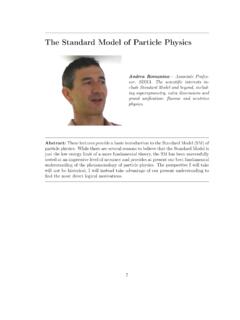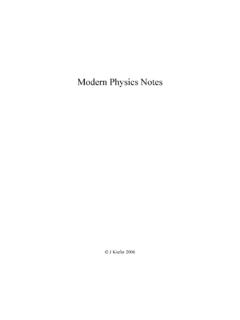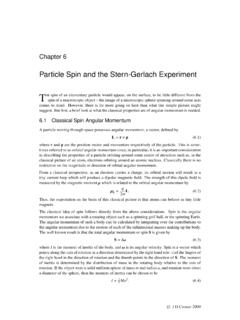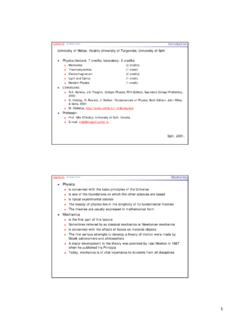Transcription of 1 Introduction 2 Creation and Annihilation Operators
1 Physics 195 Course NotesSecond Quantization030304 F. Porter1 IntroductionThis note is an Introduction to the topic of second quantization , and henceto quantum field theory . In the Electromagnetic Interactions note, we havealready been exposed to these ideas in our quantization of the electromagneticfield in terms of photons. We develop the concepts more generally here, forboth bosons and fermions. One of the uses of this new formalism is that itprovides a powerful structure for dealing with the symmetries of the statesand Operators for systems with many identical Creation and Annihilation OperatorsWe begin with the idea that emerged in our quantization of the electro-magnetic field, and introduce Operators that add or remove particles from asystem, similar to the changing of excitation quanta of a harmonic follow an explicit example, suppose that we have a potential well,V(x), with single particle eigenstates 0(x), 1(x).
2 Suppose we have ann(identical) boson system, where allnbosons are in the lowest, 0, this state by|n . We assume that|n is normalized: n|n = particles are bosons, we can haven=0,1,2,..,where|0 is the statewith no particles (referred to as the vacuum ).Now define Annihilation (or destruction ) Operators according to:b0|n = n|n 1 (1)b 0|n = n+1|n+1 .(2)Note that these Operators subtract or add a particle to the system, in the state 0. They have been defined so that their algebraic properties are identicalto the raising/owering Operators of the harmonic oscillator. For example,consider the commutator:[b0,b 0]|n =(b0b 0 b 0b0)|n (3)=[(n+1) (n)]|n (4)=|n .(5)1 Thus [b0,b 0] = 1. With these Operators , we may write then-particle state interms of the vacuum state by:|n =(b 0)n n!
3 |0 .(6)As in the case of the harmonic oscillator,b 0is the hermitian conjugateofb0. To see this, consider the following: We haveb 0|n = n+1|n+1 .Thus, n+1|b 0|n = n+1,(7)and hence, n+1|b 0= n+1 n|,or n|b 0= n n 1|.(8)Likewise,b0acts as a Creation operator when acting to the left: n|b0= n+1 n+1|.(9)We may write then-particle state in terms of the vacuum state by:|n =(b 0)n n!|0 .(10)Finally, we have the number of particles operator :B0 b 0b0,withB0|n =n|n .(11)Now suppose that the particles are fermions, and define fermion annihi-lation and Creation Operators :f0|1 =|0 ,f0|0 = 0;(12)f 0|1 =0,f 0|0 =|1 .(13)In the|0 ,|1 basis, these Operators are the 2 2 matrices:f0=(0100),f 0=(0010).(14)With this explicit representation, we see that they are hermitian conjugateto each other.
4 By construction, we cannot put two fermions in the same statewith these algebraic properties of the fermion Operators are different from thoseof the boson Operators . The commutator, in the|0 ,|1 basis, is[f0,f 0]=(100 1) =I.(15)Consider the anticommutator:{f0,f 0}|1 =(f0f 0+f 0f0)|1 =|1 ,(16){f0,f 0}|0 =|0 (17)That is,{f0,f 0}=1. Also,{f0,f0}=0,(18){f 0,f 0}=0.(19)The number of particles operator isF0=f return to bosons, and consider two levels, 0and |n0,n1 bethe state withn0bosons in 0andn1bosons in 1. As before, define,b0|n0,n1 = n0|n0 1,n1 (20)b 0|n0,n1 = n0+1|n0+1,n1 ,(21)and also,b1|n0,n1 = n1|n0,n1 1 (22)b 1|n0,n1 = n1+1|n0,n1+1 .(23)In addition to the earlier commutation relations, we have that the anni-hilation and Creation Operators for different levels commute with each other:[b0,b1]=0; [b 0,b1] = 0(24)[b0,b 1]=0; [b 0,b 1] = 0(25)We can construct an arbitrary state from the vacuum by:|n0,n1 =(b 0)n0 n0!
5 (b 1)n1 n1!|0,0 (26)The total number operator is nowB=B0+B1=b 0b0+b 1b1,(27)3so thatB|n0,n1 =(n0+n1)|n0,n1 .(28)In the case of fermions, we now have four possible states:|0,0 ,|1,0 ,|0,1 ,and|1,1 . We define:f 0|0,0 =|1,0 ;f 0|1,0 =0,(29)f0|1,0 =|0,0 ;f0|0,0 =0,(30)f0|0,1 =0;f 0|1,1 =0,(31)f 1|0,0 =|0,1 ;f1|0,0 =f1|1,0 =0,(32)f 1|1,0 =|1,1 ;f1|0,1 =|0,0 ,(33)f 1|0,1 =f 1|1,1 =0;f1|1,1 =|1,0 .(34)But we must be careful in writing down the remaining actions, off0,f 0onthe states withn1= 1. These actions are constrained by consistency withthe exclusion principle. We must get a sign change if we interchange thetwo fermions in a state. Thus, consider using thefandf Operators to interchange the two fermions in the|1,1 state: First, take the fermionaway from 1,|1,1 |1,0 =f1|1,1.
6 (35)Then move the other fermion from 0to 1,|1,0 |0,1 =f 1f0|1,0 .(36)Finally, restore the other one to 0,|0,1 f 0|0,1 =f 0f 1f0f1|1,1 (37)We require the result to be a sign change, ,f 0|0,1 = |1,1 .(38)Sincef0is the hermitian conjugate off 0,wealsohavef0|1,1 = |0,1 .We therefore have the anticommutation relations:{f0,f 0}={f1,f 1}=1.(39)All other anticommutators are zero, including{f0,f1}={f0,f 1}=0,fol-lowing from the antisymmetry of fermion states under may generalize these results to spaces with an arbitrary number ofsingle particle states. Thus, let|n0,n1,.. be a vector in such a space. Forthe case of bosons, we have, in general:[bi,b j]= ij,(40)[bi,bj]=[b i,b j]=0,(41)|n0,n1,.. = (b 1)n1 n1!
7 (b 0)n0 n0!|0 ,(42)where|0 represents the vacuum state, with allni= 0. Note that theseare the same as the photon Annihilation and Creation Operators A , A,thatwe defined in the Electromagnetic Interactions note, except for the 2 / the fermion case, we have the generalization:{fi,f j}= ij,(43){fi,fj}={f i,f j}=0,(44)|n0,n1,.. = (f 1)n1(f 0)n0|0 .(45)The number Operators are similar in both cases:B= Bi= ib ibi,(46)F= Fi= if ifi,(47)and [Bi,Bj]=[Fi,Fj]= Field OperatorsConsider now plane wave states in a bo x(rectangular volumeV,sidesLi,i=1,2,3), with periodic boundary conditions: k(x)=eik x V,(48)whereki=2 nj/Li,nj=0, 1, 2,.. The Creation operatora ks(aiseitherborf, for bosons or fermions, respectively), adds a particle with5momentumkandspinprojections; the annilation operatoraksremovesone.
8 Note that k(x) is the amplitude atxto find a particle added bya consider the operator : s(x) ke ik x Va ks.(49)This operator adds a particle in a superpositon of momentum states withamplitudee ik x V, so that the amplitude for finding the particle atx added by s(x) is a coherent sum of amplitudeseik x / V, with coefficientse ik x/ is, the amplitude atx is ke ik x Veik x V= (3)(x x )(50)[by Fourier series expansion of (3)(x x ):g(x )=1V keik x Vd3(x )e ik x g(x ),(51)withg(x )= (3)(x x )].The operator s(x) thus adds a particle atx it creates a particle atpointx(with spin projections). Likewise, the operator s(x) keik x Vaks(52)removes a particle atx. The Operators s(x)and s(x) are called field op-erators.
9 They have commutation relations following from the commutationrelations for theaanda Operators : s(x) s (x ) s (x ) s(x) = 0(53) s(x) s (x ) s (x ) s(x)=0,(54)where the upper sign is for fermions, and the lower sign is for bosons. Forbosons, adding (or removing) a particle atxcommutes with adding one atx . For fermions, adding (or removing) a particle atxanticommutes with6adding one atx .Also, s(x) s (x ) s (x ) s(x)= k,k eik xeik x V{{fks,f k s }[bks,b k s ](55)= k,k eik xeik x V kk ss (56)= keik (x x V ss (57)= (x x ) ss .(58)Thus, adding particles commutes (bosons) or anticommutes (fermions) withremoving them, unless it is at the same point and spin projection. If it isat the same point (and spin projection) we may consider the case with noparticle originally there the term gives zero, but the term doesnot, since it creates a particle which it then we suppress the spin indices, we construct a state withnparticles atx1,x2,x3.)}
10 ,xnby:|x1,x2,x3,..,xn =1 n! (xn).. (x1)|0 .(59)Note that such states form a useful basis for systems of many identical par-ticles, since, by the commutation relations of the s, they have the desiredsymmetry under interchanges ofxi example, for fermions, (x2) (x1)= (x1) (x2)(60)gives|x2,x1,x3,..,xn = |x1,x2,x3,..,xn .(61)Note also that we can add another particle, and automatically maintain thedesired symmetry: (x)|x1,x2,x3,..,xn = n+1|x1,x2,x3,..,xn,x .(62)1 These Hilbert spaces of multiple, variable numbers of particles , are known as let us evaluate: (x)|x1,x2,x3,..,xn =1 n! (x) (xn).. (x1)|0 =1 n![ (3)(x xn) (xn) (x)] (xn 1).. (x1)|0 =1 n![ (3)(x xn)|x1,x2,..,xn 1 (3)(x xn 1)|x1,x2.]






